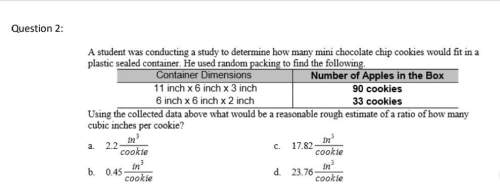
Mathematics, 09.09.2019 19:30 Ackussinglake63
Correct answers only ! if you don't know the answer, then don't guess or say what you think it is.
a student was conducting a study to determine how many mini chocolate chip cookies would fit in a plastic sealed container. he used random packing to find the following.
using the collected data above what would be a reasonable rough estimate of a ratio of how many cubic inches per cookie?
a. 2.2 in^3/cookie
b. 0.45 in^3/cookie
c. 17.82 in^3/cookie
d. 23.76 in^3/cookie


Answers: 2


Another question on Mathematics

Mathematics, 21.06.2019 18:30
The volume of gas a balloon can hold varies directly as the cube of its radius. imagine a balloon with a radius of 3 inches can hold 81 cubic inches of gas. how many cubic inches of gas must be released to reduce the radius down to 2 inches?
Answers: 2

Mathematics, 21.06.2019 19:20
Ab and bc form a right angle at point b. if a= (-3,-1) and b= (4,4) what is the equation of bc?
Answers: 1

Mathematics, 21.06.2019 19:50
Which of the following describes the graph of y--4x-36 compared to the parent square root function? stretched by a factor of 2, reflected over the x-axis, and translated 9 units right stretched by a factor of 2, reflected over the x-axis, and translated 9 units left stretched by a factor of 2, reflected over the y-axis, and translated 9 units right stretched by a factor of 2, reflected over the y-axis, and translated 9 units left save and exit next submit
Answers: 1

Mathematics, 21.06.2019 20:00
In new york city at the spring equinox there are 12 hours 8 minutes of daylight. the longest and shortest days of the year very by two hours and 53 minutes from the equinox in this year the equinox falls on march 21 in this task you use trigonometric function to model the hours of daylight hours on certain days of the year in new york city a.what is the independent and dependent variables? b.find the amplitude and the period of the function. c.create a trigonometric function that describes the hours of sunlight for each day of the year. d. graph the function you build in part c. e. use the function you build in part c to find out how many fewer daylight hours february 10 will have than march 21. you may look at the calendar.
Answers: 1
You know the right answer?
Correct answers only ! if you don't know the answer, then don't guess or say what you think it is....
Questions


Mathematics, 26.08.2019 02:00




Mathematics, 26.08.2019 02:00


Geography, 26.08.2019 02:00


Mathematics, 26.08.2019 02:00


Mathematics, 26.08.2019 02:00



Biology, 26.08.2019 02:00


Chemistry, 26.08.2019 02:00

Mathematics, 26.08.2019 02:00


English, 26.08.2019 02:00



